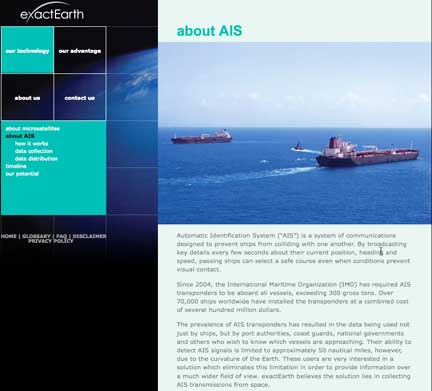[SatNews] The S-AIS trial for SAMSA has turned out to be quite successful for this company.
exactEarth Ltd. is the data services subsidiary of COM DEV International Ltd. (TSX: CDV) and their space-based Automatic Identification System (S-AIS) data has been used successfully by the South African Maritime Safety Authority (SAMSA) in an ongoing trial. The data recently contributed to security efforts associated with the 2010 FIFA World Cup tournament. South Africa’s proximity to some of the world’s busiest shipping lanes and its vast area of Search and Rescue (SAR) responsibility make effective maritime surveillance a high priority. SAMSA is evaluating S-AIS technology for its potential to improve safety and security by enabling authorities to monitor and communicate with ships identified by their AIS signals. The exactAIS™ data service delivers satellite-based AIS messages directly to end users for a variety of maritime surveillance applications. exactAIS provides the most capable satellite-based solution in the world, offering detection rates many times higher than other systems. Further satellite launches will take place later in 2010 and into 2011, expanding the constellation and providing improved revisit times and even greater vessel detection rates. The exactAIS service is readily adaptable to existing customer display systems. In this case, Cape Town-based Marine Data Solutions (Pty) Ltd. has integrated the S-AIS data into SAMSA’s Norcontrol IT vessel traffic management system.
“We’ve been very impressed with the quality of data exactEarth has provided to us,” said Capt. Karl Otto, Executive Head, Centre for Sea Watch and Response, SAMSA. “Our existing coastal AIS equipment has a limited range of 20 to 30 nautical miles and typically detects no more than a few dozen ships at a time. During the World Cup exactEarth’s space-based system was detecting over 1,000 ships. This enhanced visibility enabled our maritime security authorities to plan days in advance rather than hours.”


